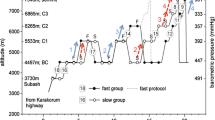Abstract
A computer-based system has been developed that enables the continuous measurement of cardiac output at rest as well as during exercise. The respiratory and motion artefacts appearing in the first derivative of the transthoracic impedance change (dZ/dt) were eliminated by adopting an ensemble averaging technique. A sufficiently high correlation was observed between cardiac outputs determined by the impedance and CO2 rebreathing methods. The system may facilitate the physiological investigation of cardiac function during exercise.
Similar content being viewed by others
References
Asmussen, E. andNielsen, M. (1956) Physiological dead space and alveolar gas pressures at rest and during muscular exercise.Acta Physiol. Scand.,38, 1–21.
Åstrand, P., Cuddy, T. E., Saltin, B. andStenberg, J. (1964) Cardiac output during submaximal and maximal work.J. Appl. Physiol.,19, 268–274.
Baker, L. E., Judy, W. V., Geddes, L. E., Langley, F. M. andHill, D. W. (1971) The measurement of cardiac output by means of electrical impedance.Cardiovascular Research Centre Bull.,9, 135–145.
Boer, P., Roos, J. C., Geyskes, G. G. andDorhout Mees, E. J. (1979) Measurement of cardiac output by impedance cardiography under various conditions.Am. J. Physiol.,237, H491–496.
Comroe, J. H. Jr., Forster, R. E., DuBois, A. B., Briscoe, W. A. andCarlsen, E. (1962) The lung. 2nd Ed., Year Book Medical Publishers, (Chicago).
Defares, J. G. (1958) Determination ofp vCO2 from the exponential CO2 rise during rebreathing.J. Appl. Physiol.,13, 159–164.
Denniston, J. C., Maher, J. T., Reeves, J. T., Cruz, J. C., Cymerman, A. andGrover, R. F. (1976) Measurement of cardiac output by electrical impedance at rest and during exercise.J. Appl. Physiol.,40, 91–95.
Ferguson, R. J., Faulkner, J. A., Lulius, S. andConway, J. (1968) Comparison of cardiac output determined by CO2 rebreathing and dye-dilution methods.J. Appl. Physiol.,25, 450–454.
Gollan, F., Kizakevich, P. N. andMcDermott, J. (1978) Continuous electrode monotoring of systolic time intervals during exercise.Brit. Heart J.,40, 1390–1396.
Ito, H., Yamakaoshi, K. andTogawa, T. (1977) A model study of stroke volume values calculated from impedance and their relation to the waveform of blood flow.IEEE Trans.,BME-24, 489–491.
Jernérus, R., Lundin, G. andThomson, D. (1963) Cardiac output in healthy subjects determined with a CO2 rebreathing method.Acta Physiol. Scand.,59, 390–399.
Klausen, K. (1965) Comparison of CO2 rebreathing and acetylene methods for cardiac output.J. Appl. Physiol.,20, 763–766.
Kobayashi, Y., Andoh, Y., Fujinami, T., Nakamura, K., Takada, K., Takeuchi, T. andOkamoto, M. (1978). Impedance cardiography for estimating cardiac output during submaximal and maximal work.J. Appl. Physiol.,45, 459–462.
Kubicek, W. G., Karnegis, J. M., Patterson, R. P., Witsoe, D. A. andMattson, R. H. (1966) Development and evaluation of an impedance cardiac output system.Aerospace Med.,37, 1208–1212.
Kubicek, W. G., Patterson, R. P. andWitsoe, D. A. (1970) Impedance cardiography as a noninvasive method of monitoring cardiac function and other parameters of the cardiovascular system.Ann. NY Acad. Sci.,170, 724–732.
Muiesan, G., Sorbini, C. A., Solinas, E., Grassi, V., Casucci, G. andPetz, E. (1968) Comparison of CO2-rebreathing and direct Fick methods for determining cardiac output.J. Appl. Physiol.,24, 424–429.
Smith, J. J., Bush, J. E., Wiedmeier, V. T. andTristani, F. E. (1970) Application of impedance cardiography to study of postural stress.J. Appl. Physiol. 29, 133–137.
Tanaka, K., Kanai, H., Nakayama, K. andOno, N. (1970) The impedance of blood: the effects of red cell orientation and its application.Jpn. J. Med. Eng. 8, 436–443.
Van der Hoeven, G. M. A., Clerens, P. J. A., Donders, J. J. H., Beneken, J. E. W. andVonk, J. T. C. (1977) A study of systolic time intervals during uninterrupted exercise.Brit. Heart. J.,39, 242–254.
Vanfraechem, J. H. P. (1979) Stroke volume and systolic time interval adjustments during bicycle exercise.J. Appl. Physiol.,46, 588–592.
Yu-Tang, S. andWen-Ti, S. (1979) Comparative study on measurement of stroke volume by impedance method and electromagnetic flow method.Chinese Med. J.,92, 79–84.
Author information
Authors and Affiliations
Rights and permissions
About this article
Cite this article
Miyamoto, Y., Takahashi, M., Tamura, T. et al. Continuous determination of cardiac output during exercise by the use of impedance plethysmography. Med. Biol. Eng. Comput. 19, 638–644 (1981). https://doi.org/10.1007/BF02442779
Received:
Accepted:
Issue Date:
DOI: https://doi.org/10.1007/BF02442779



